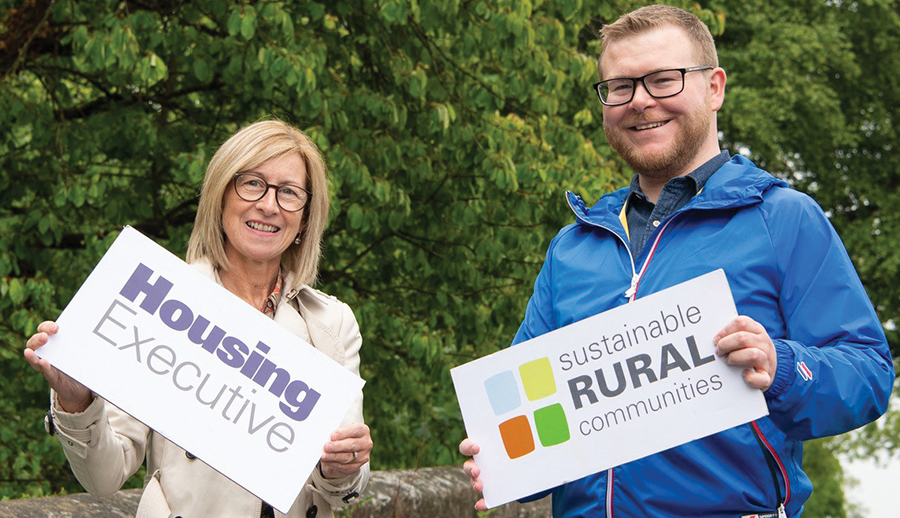Reaching rural

Siobhan McCauley, Director of Regional Services, outlines the Housing Executive’s role in providing housing and housing services in rural areas.
The Housing Executive is more than just Northern Ireland’s largest social housing landlord. As the strategic housing authority for Northern Ireland, we undertake a range of statutory duties, to ensure that housing services are provided for people living in both urban and rural areas.
Last year we launched our sixth rural strategy, ‘Reaching Rural’. The strategy reflects the growing demand, and changing policy context for the development of new rural homes.
We understand that there are additional challenges faced by rural residents, most notably for those living in more remote areas. Everyday life in a rural area presents unique hurdles that those in urban areas take for granted – having to travel to access key services, a reduced public transport system, over-reliance on private cars, slower broadband speeds and unreliable mobile network signals.
‘Reaching Rural’ focuses on the need to consider the housing requirements of an ageing population, the growing recognition of the requirement for carbon neutral, energy efficient, rural homes, and the access to basic services and support. It recognises that these factors present both challenges and opportunities. We want to address these through local engagement, investment, and collaborative working. We are already working with our Community Planning partners to find sustainable opportunities within rural settlements.
It is important to note that 15 per cent of all social housing waiting list applicants require a home in a rural location. The number of households on the waiting list for a rural home has increased over the past five years to 6,630 and the number of those in housing stress has also continued to rise year-on-year to 4,243. This highlights the gap between supply and demand and the difficulty many applicants face in securing a social home. The rise in housing stress in rural areas is often exacerbated by the fact that there are increasing difficulties in achieving social new build schemes in rural areas.
During the period of our last Rural Strategy (2016 to 2021), 671 new social housing homes commenced in rural areas through the Social Housing Development Programme. This is not simply a case of providing people a place to call home that is affordable and meets their needs, but this investment will has a ripple effect in rural communities, supporting schools, services and local businesses.
While this is a positive step for our rural communities and for those households who have been waiting for new homes, it is far short of what we want to see delivered. Between 2016 and 2021, our strategic target was under by 355. Similarly, during 2021/22 only 7.5 per cent of all starts were in a rural location, against a target of 12.3 per cent.

Our annual programme of Rural Housing Need Tests is a strategic priority. Tests are a focused consultation with an individual community to encourage anyone in need of a home to come forward and have an initial discussion with a housing advisor about their housing circumstances, and the housing options available within their area of choice. If we determine there is a need for more housing in the area, we will consider support for a housing association proposal, or highlight the area in the Annual Commissioning Prospectus. Since testing first began in 2000, we have carried out over 200 tests, which has resulted in over 400 new homes for rural residents to stay and to thrive in rural communities.
We continue to work with housing association partners, to identify the main issues contributing to this shortfall. The increased difficulty in accessing land which is suitable and available for housing development; the impact of the cost of required infrastructure, and in particular the ongoing capacity issues will have on the feasibility of small schemes, are some of the issues that we collectively face. There is often limited land remaining within development limits. In addition to this, existing land prices are competitive in many rural settlements where we have the greatest housing need.
We recognise that more needs to be done to ensure the delivery of the rural homes required. A key theme of our strategy is ‘enabling the provision of affordable rural homes’ – we have set out a range of actions aimed at facilitating this provision. Our rolling programme of Site Identification Studies assist housing associations by identifying available land in rural areas of unmet housing need. This approach helps to promote the inclusion of rural schemes on the Social Housing Development Programme. It further develops our understanding of local land, infrastructure, and planning-related issues that informs our continued consultation with local councils regarding the development of Local Development Plans.
The waiting list figures illustrated provide evidence of the growing need for an increase in the supply of social housing in many rural settlements across Northern Ireland. As far back as our first rural housing policy in 1991, the Housing Executive recognised that there are rural settlements where there are fewer, if any, social properties. Limited awareness of social housing as an option and a low turnover of existing stock means that fewer numbers of people in need of social and affordable housing are identified. This perpetuates the issue of a lack of housing supply in areas where social homes are most needed.
We are fortunate to work with many amazing community groups and volunteers who are the backbone of our communities. This invaluable contribution from people living in rural communities, including those on our Rural Residents Forum, is essential to build sustainable rural communities.
Find more about our rural work on:
E: rural.housing@nihe.gov.uk.
W: www.nihe.gov.uk/Community/rural-issues






